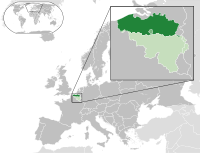Transport in Flanders
Transport in Flandersis run in two levels regarding the federal nature ofBelgiumwith certain functions run on behalf of the nationalCabinet of Belgiumand other functions run on behalf ofFlemish Government. Therefore, the railways are run at national level byNMBSand are under the auspices of theCabinet of Belgium,whilst the light railways are run at regional level byDe Lijnunder the auspices of theFlemish Government.The railway infrastructure is managed byInfrabeland thus is under the auspices of theCabinet of Belgium.
Railways[edit]

TheNMBSruns frequent trains acrossFlandersconnecting the 142 stations in the region with each other, with Brussels and Wallonia and in some cases with France, The Netherlands, Luxembourg or Germany. Except for a few 'cities' (that generally have obtained the city status a long time ago and now only have around 10.000 citizens) in West Flanders and Limbourg, all Flemish cities as well as most villages have important railway stations. The most important railway line is theBelgian railway line 50AconnectingOostendewithBrugge,Gent-Sint-PetersandBrussel Zuid-Bruxelles Midi(along the E40).De Lijnruns trams inGhent,Antwerpwith theAntwerp Pre-metroand also the coastal tramKusttram.
Water[edit]
Ports and harbours[edit]

Sea ports[edit]
- Antwerp-Port of Antwerp[1](one of the world's busiest ports)
- Bruges(Zeebrugge) -Port of Bruges-Zeebrugge[2](one of the busiest in Europe)
- Ghent-Port of Ghent[3]
- Ostend-Port of Ostend[4]
Lighthouse[edit]
Former ferries that accepted foot passengers[edit]
Regie voor Maritiem Transportwas a national company that closed in 1997, which ran ferries toDover Western DocksfromOostende.


